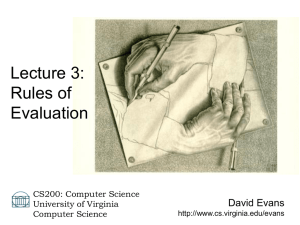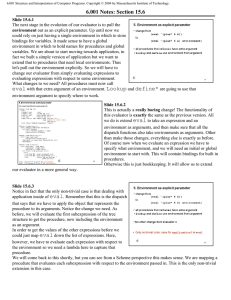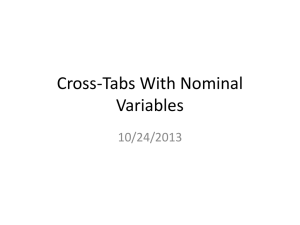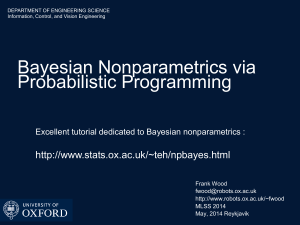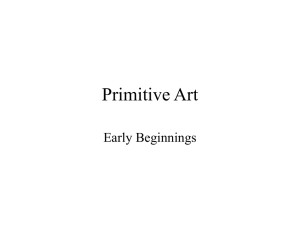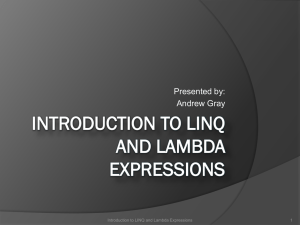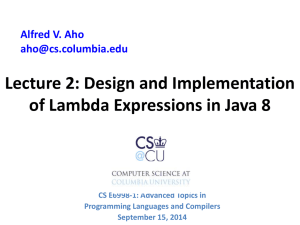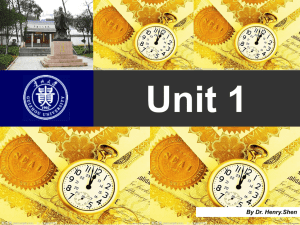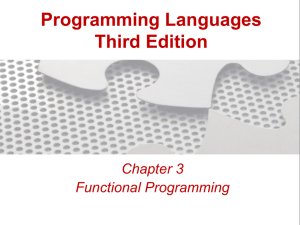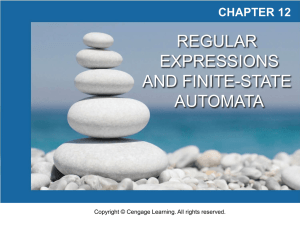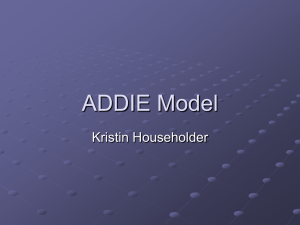Class 3: Rules of Evaluation
advertisement
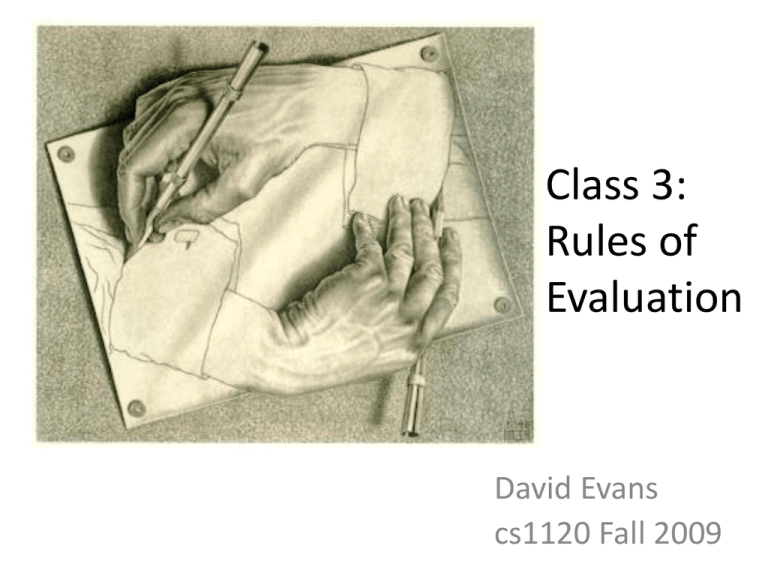
Class 3: Rules of Evaluation David Evans cs1120 Fall 2009 Menu • Questions from Notes – Computing photomosaics, non-recursive languages, hardest language elements to learn • Scheme’s Rules of Evaluation – (break: Survey Responses) 2 If it takes 60 seconds to compute a photomosaic for Problem Set 1 today on a typical PC, estimate how long it will take cs1120 students in 2012 to compute the same photomosaic? How long will it take in 2015? > (/ (* (- 2012 2009) 12) 18) 2 Difference in years * 12 = number of months Number of months / 18 = number of doublings > (/ 60 (* 2 2)) according to Moore’s Law 15 > (/ (* (- 2015 2009) 12) 18) 60 seconds today, 2 doublings by 2012 4 15 seconds in 2012 > (/ 60 (* 2 2 2 2)) 15/4 > (exact->inexact (/ 60 (* 2 2 2 2))) 3.75 Reality check: 60 seconds today, 4 doublings by 2015 3.75 seconds in 2015 Moore’s “law” is just an “observation”. 3 Are there any non-recursive natural languages? What would happen to a society that spoke one? Not for humans at least. They would run out of original things to say. Chimps and Dolphins are able to learn nonrecursive “languages”, but only humans have learned recursive languages. 4 Running out of Ideas “Its all been said before.” Eventually true for a non-recursive language. Never true for a recursive language. There is always something original left to say! 5 Language Elements When learning a foreign language, which elements are hardest to learn? • Primitives: lots of them, and hard to learn real meaning • Means of Combination – Complex, but, all natural languages have similar ones [Chomsky] SOV (45% of all languages) SVO (42%) VSO (9%) Sentence ::= Subject Object Verb (Korean) Sentence ::= Subject Verb Object (English) Sentence ::= Verb Subject Object (Welsh) “Lladdodd y ddraig y dyn.” (Killed the dragon the man.) OSV (<1%): Scheme: Tobati (New Guinea) Expression ::= (Verb Object) • Means of Abstraction: few of these, but tricky to learn differences across languages English: I, we Tok Pisin (Papua New Guinea): mi (I), mitupela (he/she and I), mitripela (both of them and I), mipela (all of them and I), yumitupela (you and I), yumitripela (both of you and I), yumipela (all of you and I) Scheme: define 6 Pages in Revised5 Report on the Algorithmic Language Scheme Primitives Means of Combination Means of Abstraction 48 pages total (includes formal specification and examples) Pages in Revised5 Report on the Algorithmic Language Scheme Primitives Means of Combination Means of Abstraction Standard Procedures Primitive expressions Identifiers, numerals 18 2 1 Expressions Program structure 2 2 Definitions ½ 48 pages total (includes formal specification and examples) Pages in Revised5 Report on the Algorithmic Language Scheme Primitives Means of Combination Means of Abstraction Standard Procedures Primitive expressions Identifiers, numerals 18 2 1 Expressions Program structure 2 2 Definitions ½ 48 pages total (includes formal specification and examples) Pages in C++ Language Specification (1998) Pages in Revised5 Report on the Algorithmic Language Scheme Primitives Means of Combination Means of Abstraction Standard Procedures Primitive expressions Identifiers, numerals Pages in C++ Language Specification (1998) 18 Standard Procedures 2 Primitive expressions 1 Identifiers, numerals 356 30 10 Expressions Program structure 2 Expressions, Statements 2 Program Structure 197 35 Definitions ½ Declarations, Classes 173 48 pages total (includes formal specification and examples) 776 pages total (includes no formal specification or examples) C++ Core language issues list has 948 items! Pages in Revised5 Report on the Algorithmic Language Scheme Primitives Means of Combination Means of Abstraction Standard Procedures Primitive expressions Identifiers, numerals Expressions Program structure Definitions 48 pages total (includes formal specification and examples) English 18 Morphemes 2 Words in Oxford 1 English Dictionary 2 Grammar Rules 2 English Grammar for Dummies Book ½ Pronouns ? 500,000 100s (?) 384 pages ~20 Rules of Evaluation Scheme Grammar Program ::= ε | ProgramElement Program ProgramElement ::= Expression | Definition Definition ::= (define Name Expression) Expression ::= PrimitiveExpression | NameExpression | ApplicationExpression | ProcedureExpression | IfExpression PrimitiveExpression ::= Number | true | false | PrimitiveProcedure NameExpression ::= Name ApplicationExpression ::= (Expression MoreExpressions) MoreExpressions ::= ε | Expression MoreExpressions ProcedureExpression ::= (lambda (Parameters) Expression) Parameters ::= ε | Name Parameters IfExpression ::= (if ExpressionPred ExpressionConsequent ExpressionAlt) 13 Assigning Meanings Program ::= ε | ProgramElement Program ProgramElement ::= Expression | Definition Definition ::= (define Name Expression) Expression ::= PrimitiveExpression | NameExpression | ApplicationExpression | ProcedureExpression | IfExpression PrimitiveExpression ::= Number | true | false| PrimitiveProcedure NameExpression ::= Name ApplicationExpression ::= (Expression MoreExpressions) MoreExpressions ::= ε | Expression MoreExpressions ProcedureExpression ::= (lambda (Parameters) Expression) Parameters ::= ε | Name Parameters IfExpression ::= (if ExpressionPred ExpressionConsequent ExpressionAlt) This grammar generates (nearly) all surface forms in the Scheme language. What do we need to do to know the meaning of every Scheme program? 14 Definitions Program ::= ε | ProgramElement Program ProgramElement ::= Expression | Definition Definition ::= (define Name Expression) A definition associates the value of its expression with the name. (define two 2) After this definition, the value associated with the name two is 2. 15 Expressions and Values • (Almost) every expression has a value – Have you seen any expressions that don’t have values? • When an expression with a value is evaluated, its value is produced Our goal is to define a meaning function, Eval, that defines the value of every Scheme expression: Eval(Expression) Value Today we do this informally with rules in English. 16 Primitive Expressions PrimitiveExpression ::= Number | true | false | PrimitiveProcedure 17 Evaluation Rule 1: Primitives If the expression is a primitive, it evaluates to its pre-defined value. >2 2 > true #t >+ #<primitive:+> Primitives are the smallest units of meaning: they can’t be broken down further, you need to know what they mean. 18 Name Expressions Expression ::= NameExpression NameExpression ::= Name 19 Evaluation Rule 2: Names A name evaluates to the value associated with that name. > (define two 2) > two 2 Caveat: this simple rule only works if the value associated with a name never changes (until PS5). 20 Application Expressions Expression ::= Application Expression ApplicationExpression ::= (Expression MoreExpressions) MoreExpressions ::= ε MoreExpressions ::= Expression MoreExpressions 21 Evaluation Rule 3: Application 3. To evaluation an application expression: a) Evaluate all the subexpressions (in any order) b) Apply the value of the first subexpression to the values of all the other subexpressions. (Expression0 Expression1 Expression2 … ) Rules for Application 1. Primitives. If the procedure to apply is a primitive procedure, just do it. 2. Constructed Procedures. If the procedure is a constructed procedure, evaluate the body of the procedure with each parameter name bound to the corresponding input expression value. 23 Eval and Apply are defined in terms of each other. Without Eval, there would be no Apply, without Apply there would be no Eval! Eval Apply 24 Survey Responses: Majors 28 20 7 4 3 3 3 2 1 Cognitive Science Computer Science Psychology Math Economics Commerce/Pre-Commerce Undeclared Physics Environmental Sciences, English, Music 25 Survey Responses: PS Partners Missing, 4 No, 30 Yes, 29 For PS2 everyone will be assigned a partner. For other problem sets, you’ll have different options. 26 Survey Responses: Office Hours • Scheduling office hours: (Set Cover Problem) – Input: a set of sets of available times – Output: the minimum size set that includes at least one element from each of the input sets Later in the course, we’ll see that this problem is equivalent to the problem of computing an optimal photomosaic! • My office hours will be: – Mondays, 1:30-2:30pm [Olsson 236A] – Tuesdays, 10:30-11:30am [Wilsdorf Cafe] Not a set cover: Everyone who selected at least three possible times can make at least one of these. If you can’t make office hours, email to arrange an appointment. 27 Honor Pledge 28 Finishing Scheme Meanings Program ::= ε | ProgramElement Program ProgramElement ::= Expression | Definition Definition ::= (define Name Expression) Expression ::= PrimitiveExpression | NameExpression | ApplicationExpression | ProcedureExpression | IfExpression PrimitiveExpression ::= Number | true | false| PrimitiveProcedure NameExpression ::= Name ApplicationExpression ::= (Expression MoreExpressions) MoreExpressions ::= ε | Expression MoreExpressions ProcedureExpression ::= (lambda (Parameters) Expression) Parameters ::= ε | Name Parameters IfExpression ::= (if ExpressionPred ExpressionConsequent ExpressionAlt) 29 Making Procedures lambda means “make a procedure” Expression ::= ProcedureExpression ProcedureExpression ::= (lambda (Parameters) Expression) Parameters ::= ε Parameters ::= Name Parameters 30 Evaluation Rule 4: Lambda A lambda expression evaluates to a procedure that takes the given parameters and has the expression as its body. ProcedureExpression ::= (lambda (Parameters) Expression) Parameters ::= ε | Name Parameters 31 Lambda Example: Tautology Function (lambda () true) make a procedure with no parameters with body true > ((lambda () true) 1120) #<procedure>: expects no arguments, given 1: 1120 > ((lambda () true)) #t > ((lambda (x) x) 1120) 1120 Next class we’ll follow the evaluation rules through more interesting examples. 32 Evaluation Rule 5: If IfExpression ::= (if ExpressionPredicate ExpressionConsequent ExpressionAlternate) To evaluate an if expression: (a) Evaluate ExpressionPredicate. (b) If it evaluates to a false value, the value of the if expression is the value of ExpressionAlternate; otherwise, the value of the if expression is the value of ExpressionConsequent. 33 Completeness of Evaluation Rules Program ::= ε | ProgramElement Program ProgramElement ::= Expression | Definition Definition ::= (define Name Expression) Expression ::= PrimitiveExpression | NameExpression | ApplicationExpression | ProcedureExpression | IfExpression PrimitiveExpression ::= Number | true | false| PrimitiveProcedure NameExpression ::= Name ApplicationExpression ::= (Expression MoreExpressions) MoreExpressions ::= ε | Expression MoreExpressions ProcedureExpression ::= (lambda (Parameters) Expression) Parameters ::= ε | Name Parameters IfExpression ::= (if ExpressionPred ExpressionConsequent ExpressionAlt) Since we have an evaluation rule for each grammar rule, we can determine the meaning of any Scheme program! 34 Now You Can Write Any Program! • You know enough now to define a procedure that performs every possible computation! – We’ll prove this later in the course • We’ll learn some more useful Scheme forms: – There are a few more special forms (like if) – But, none of these are necessary…just helpful • We have not defined the evaluation rules precisely enough to unambiguously understand all programs (e.g., what does “value associated with a name” mean?) 35 Charge • PS1 Due at beginning of class Wednesday • Read Chapter 4 by Friday • Now you know enough to produce every computation, the rest is just gravy: – More efficient, elegant ways to express computations – Ways to analyze the computations 36
